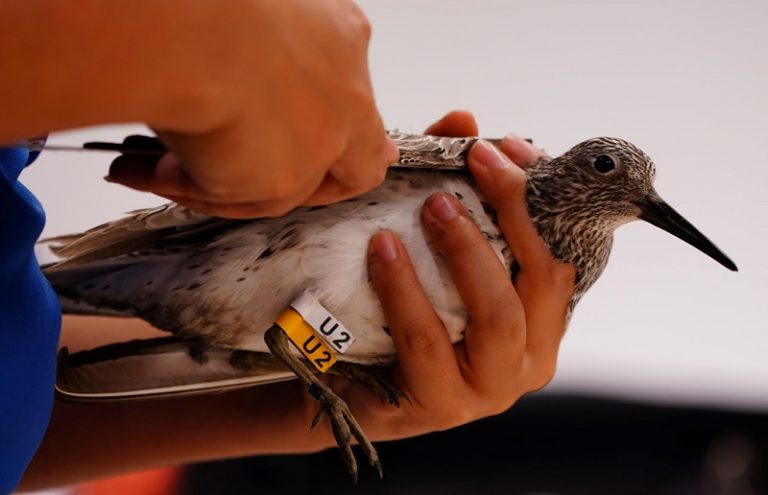← Back
The Hong Kong Bird Watching Society shares their experience with Argos to help understand migration routes and stopover sites of the Great Knot

The Great Knot is an endangered shorebird and a long-distance migrant. Its activity was found to be mainly along the coast and was suspected to have few stopovers; while juveniles were recorded moving approximately 3,000 km within ten days (Tomkovich, 1997).
While we know the Great Knot lives in Northeast Siberia and spends winter mainly in Southeast Asia and South of Australia, its distribution is poorly understood. Tracking Great Knots using the Argos satellite system helps us understand the species’ migration routes, stopover sites and wintering grounds, thus enabling better protection for the species.
During breeding season, Great Knots mainly feed on plant materials such as berries and also kernels of dwarf pine trees, only small chicks feed exclusively on insects. In non-breeding season, Great Knots feed mainly on bivalves, and also gastropods, crustaceans, annelids and sea cucumbers.
They search primarily by probing in mud, also by pecking and gleaning. The species is known to be nocturnal and diurnal forager. Great Knots migrate between Russia, China, and the Korean Peninsula, and could reach as far as south of Australia. They fly over the continent, using the “East Asian – Australasian Flyway”.
Tracking Great Knots
The Hong Kong Bird Watching Society (HKBWS) began a new initiative to track coastal migratory birds in 2021 with a project sponsored by Swire TrustTomorrow.
Two Great Knots were tagged with 2g solar-powered Argos PTTs. The tagging took place during mid-April 2021 while they were in Mai Po Nature Reserve, Hong Kong. Hong Kong is a regular stopover for this endangered species, with up to hundreds of individuals in spring and smaller number in other seasons.
Both individuals were recorded to have left Hong Kong on 20th and 23rd April 2021 respectively and arrived in the Zhejiang Province of China in late April 2021.

The journey begins
After leaving the Zhejiang Province of China, they flew to North Korea and spent approximately a month there, before heading further north to Russia in late May, arriving at their breeding ground. One individual eventually reached Okhotsky, Russia, which is approximately 4,900km away from Hong Kong; while the other one flew across Sea of Okhotsk, which is approximately 6,000km away from Hong Kong.
In July 2021, the two Great Knots embarked on their southward migration journey. They spent two months in the Liaoning Province of China and DPR Korea, respectively. In October, amidst the migration season, it was quite bewildering to see the Great Knots had not travelled further south. According to the tracking data, the Great Knots stopped for a bit to refuel themselves before a long journey.

Recent updates
In November, there were quite some exciting updates: after taking a long break, the Great Knots had started migrating further south and arrived in the Philippines on 3rd and 9th, respectively. We were thrilled to see the Great Knots flying approximately 2,800km in just a few days!
The HKBWS will stay tuned and keep monitoring latest movements of the Great Knots. Meanwhile, more tracking studies are also planned. It is certain that the data collected will contribute to our understanding of the migration and foraging habits of the endangered Great Knot. In the meantime, the HKBWS has prepared a video showing the tracking of Great Knots which you can visit here: https://www.youtube.com/watch?v=7DddPQ22T2E

Reference
Pavel S. Tomkovich (1997) Breeding Distribution, Migrations and Conservation Status of the Great Knot Calidris tenuirostris in Russia, Emu – Austral Ornithology, 97:4, 265-282, DOI: 10.1071/MU97040

